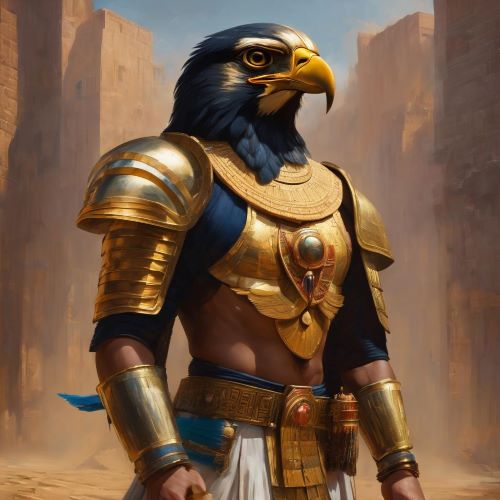Hathor : Goddess of Love
Listen
At a glance
| Description | |
|---|---|
| Origin | Egyptian Mythology |
| Classification | Gods |
| Family Members | Ra (Father), Bastet, Sekhmet (SIsters), Horus Husband) |
| Region | Egypt |
| Associated With | Love, Childbirth, Lust |
Hathor
Introduction
The goddess of the sky, Hathor, was a religion in ancient Egypt. She was worshipped during the early dynastic periods. The name she used, which means “estate of Horus,” may have been her own. She was associated with motherhood and was closely related to Re of Heliopolis, who was the sun god. At her cult center at Dandarah in Upper Egyptian, she was also regarded as a goddess of love and fertility.
Hathor was worshipped in various towns in Egypt and abroad. She was known for her role as a patroness of foreign areas, such as the turquoise mines in Sinai. In Thebes, she was also regarded as a goddess of the west. During the Late Period, during which the Greeks identified her with their deity Aphrodite, women wanted to be associated with her.
Physical Traits
Although she was most commonly regarded as a cow-headed woman, Hathor was also depicted in various ways. Some of these include a woman with horns and a solar disk, which made it hard to differentiate her from Isis.
Although the Eye of Ra was only a solar disk, it was regarded as a manifestation of Hathor, and both Mut and Bastet shared this distinction. Hathor was sometimes depicted as a serpent, a plant, or a lioness. The Egyptians linked her with Mesketiu, which is the constellation of Ursa Major. The constellation looked similar to an ox’s hind leg.
Family
Although she wasn’t a central figure in the mythos of Egypt, Hathor was still very important to the country’s religious branches. There were a number of different cults that dominated the theocratic spectrum in the country.
Hathor had strange and conflicting relationships with her fellow deities due to her unusual position. Throughout the ages, she was often regarded as the daughter of Ra and Nut, the mother of Ra-Horakhty, the wife of Horus the Elder, and the mother of Ihy.She was also considered a sister to Bastet and Sekhmet.
Other names
The name Hathor literally means “House of Horus.” Her significance can be hard to determine due to the number of interpretations of it. It’s believed that the name Hathor refers to the mother of Horus. The hieroglyph for the sign, which is a falcon inside a walled enclosure, suggests that she was the wife of the falcon. Another way to interpret the sign is as a representation of the sky.
Powers and Abilities
Even though various elements of her worship changed during the time of Hathor’s reign, she was still regarded as a goddess who was associated with love, motherhood, and marriage. Her connection with Aphrodite continued until the Greco-Roman age. In addition to being a goddess of love, Hathor also had a role in music and pleasure.
The sacred ceremonies and rituals conducted by Hathor were carried out using a type of instrument known as the sistrum, which was a rattle-like instrument. Also, alcohol was a common component of her cult, and the image of the goddess was often found on storage containers filled with beer and wine. In addition, she was often depicted wearing a menat, which symbolized rebirth.
One of the most confusing elements of Egyptian mythology is the idea that both the goddess and the god can act like one another. For instance, if Hathor talked about the elements of Sekhmet, she would become Sekhmet. Likewise, if the devotees placated Sekhmet, they would turn her into a more benign deity.
Modern Day Influence
While some of the most prominent Egyptian deities were able to capture the imaginations of modern generations, other goddesses and gods were still relatively unknown. Although she has fallen from her position as a dominant deity, Hathor is still alive and well in the modern era, thanks to the work of Elodie Yen. In 2016, Yen played the role of Hathor in Gods of Egypt, and her portrayal of the goddess was not the same one that was used in traditional mythology.
Related Images
Frequently Asked Questions
What is lorem Ipsum?
I am text block. Click edit button to change this text. Lorem ipsum dolor sit amet, consectetur adipiscing elit. Ut elit tellus, luctus nec ullamcorper mattis, pulvinar dapibus leo.
What is lorem Ipsum?
I am text block. Click edit button to change this text. Lorem ipsum dolor sit amet, consectetur adipiscing elit. Ut elit tellus, luctus nec ullamcorper mattis, pulvinar dapibus leo.
What is lorem Ipsum?
I am text block. Click edit button to change this text. Lorem ipsum dolor sit amet, consectetur adipiscing elit. Ut elit tellus, luctus nec ullamcorper mattis, pulvinar dapibus leo.
What is lorem Ipsum?
I am text block. Click edit button to change this text. Lorem ipsum dolor sit amet, consectetur adipiscing elit. Ut elit tellus, luctus nec ullamcorper mattis, pulvinar dapibus leo.
What is lorem Ipsum?
I am text block. Click edit button to change this text. Lorem ipsum dolor sit amet, consectetur adipiscing elit. Ut elit tellus, luctus nec ullamcorper mattis, pulvinar dapibus leo.












